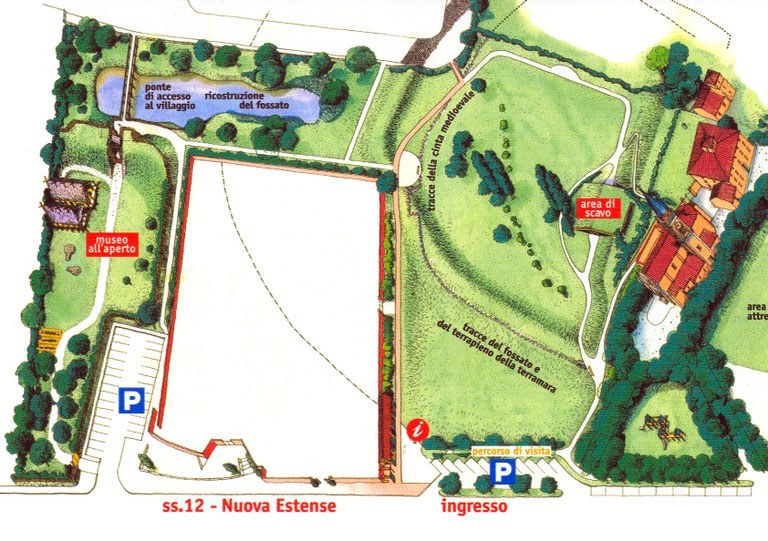Open air museum
The park at Montale features the Museum’s open-air section: a life-size replica of part of the terramare village has been reconstructed based on deductions deriving from archaeological finds.

Inside the village, a portion of the fortifications has been reconstructed, featuring the ditch and earthworks. The two structures give a good idea of the imposing artificial defence system that surrounded the Montale settlement. The ditch, which is slightly smaller than the original (about 20 metres as opposed to 35), was partly a barrier to keep out the enemy and partly a precious water reservoir. The earthworks are equipped with a palisade that lends further protection to the village and those who defended it in the event of enemy attack.
Fortifications and village gate
The gate is set back slightly behind two gateposts. This arrangement is well attested in other Italian and European Bronze Age settlements and was so constructed for reasons of defence.
Reconstruction of bronze age dwellings
Beyond the gate, two dwellings can be seen. Naturally, the village actually comprised a greater number of houses. It can be safely assumed that Montale featured between thirty and forty dwellings, with a total population close to 150 inhabitants. The houses stood next to narrow passageways that separated one dwelling from another. Broader streets formed the village’s main thoroughfares. There were also places set aside for livestock, depots and meetings.
The form of the two dwellings was deduced from evidence compiled during excavation, above all using data from phases 1 and 2, in other words the earlier phases in the development of the village. These data proved more complete.
Both dwellings are raised above ground level and are divided inside into aisles comprising rows of support poles. Adjacent to these taller poles is an equal number of smaller ones used to support the wooden floor. The houses have a double-pitch roof covered with marsh reeds fixed to the roof’s wooden frame. The walls are made of a lime, sand and horse manure mix that was spread over a framework of branches or wattles.
The furnishings and objects seen in the two dwellings were faithfully reproduced from originals uncovered in the Montale excavations, or at any rate from finds uncovered in other terramare from the same period. The houses have been furnished to represent domestic and handcraft activities (metalwork, weaving, pottery, working with deer horn) and personalised around particular social figures (warrior, craftsman, women of status).
Kilns
Near to the dwellings, two kilns have been built for firing pottery, which takes the shape of medium to large-size earthenware vessels.
Both kilns consist of a circular chamber and dome made of clay compacted with vegetable fibre, a front entrance and a chimney at the rear to favour the flow of air.
Crops
The abundance of botanical remains has yielded useful information on the way that the land around Montale was used during the centuries at the turn of the second millennium BC.
In the open-air museum section, varieties have been planted based on the documented archaeological finds: cereals (millet and rye), legumes (lentils, peas, beans) and linseed.
